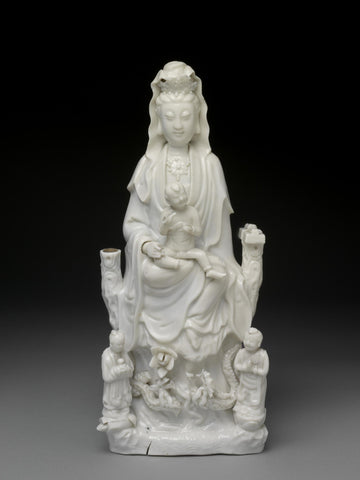
Seated Guanyin with Child and two companions
Seated Guanyin with Child and two companions, China, Dehua, Qing Dynasty (1644 - 1911), Kangxi era (1662 - 1722), 2nd Half of the 17th Century. Porcelain. H. 38 cm,
Porcelain figure of Guanyin, wearing a long draped robe, a diadem on the head and jewellery around the neck, seated on a throne with the right leg bent and holding a baby on her lap; two small boys stand at the sides of the throne and two water dragons among waves are depicted beneath the throne.
ca. 1620-1720
Guanyin, the Goddess of Compassion, is one of the most popular Buddhist deities in China. Her figure originated in India as the male bodhisattva Avalokitesvara; after the introduction of Buddhism in China, he was transformed into a female deity associated with the virtues of compassion and mercy. Guanyin was also worshipped in China as the patron of fishermen, and by women as the goddess 'bringer of sons'.
This porcelain figure of Guanyin was made at the kilns of Dehua in Fujian province, south-east China. Dehua was the second largest producer of ceramics, including export ware, after Jingdezhen. The goddess is here represented as the 'bringer of sons' with a baby on her lap and two children at the sides of her throne, but also as a protector of fishermen with two water dragons and waves at her feet. This kind of figures were usually placed on household altars and worshipped as devotional images. By the late 17th century they were also exported to Europe, where the body and colour of the Dehua ware, also known as 'blanc de Chine', were much admired.
